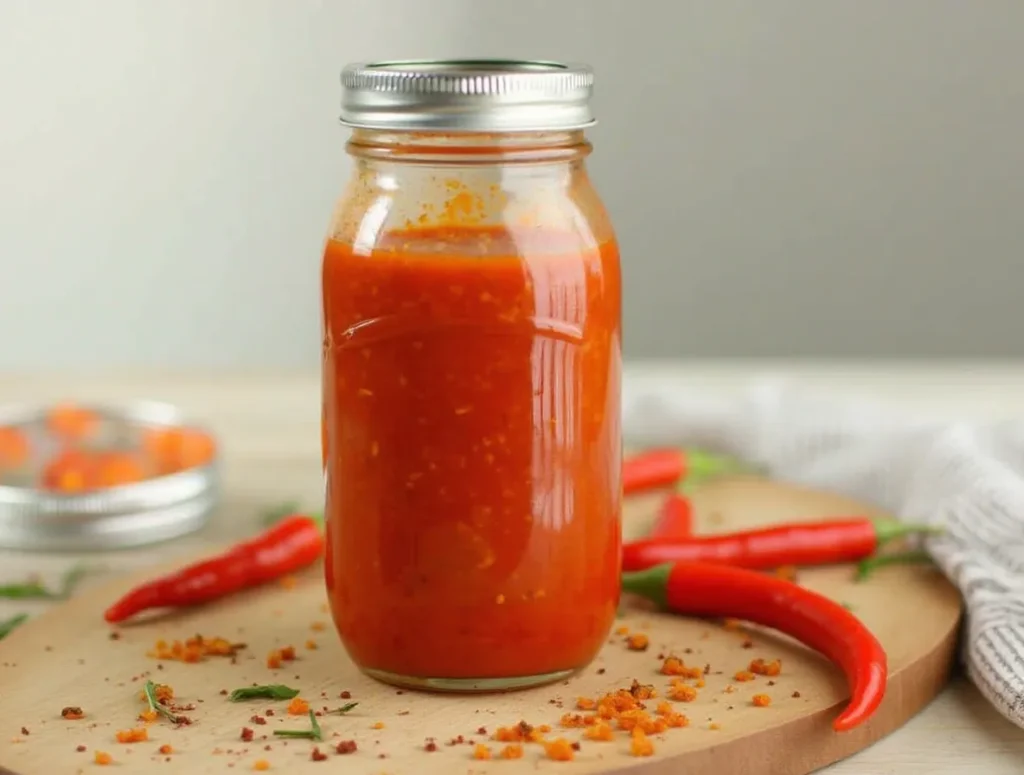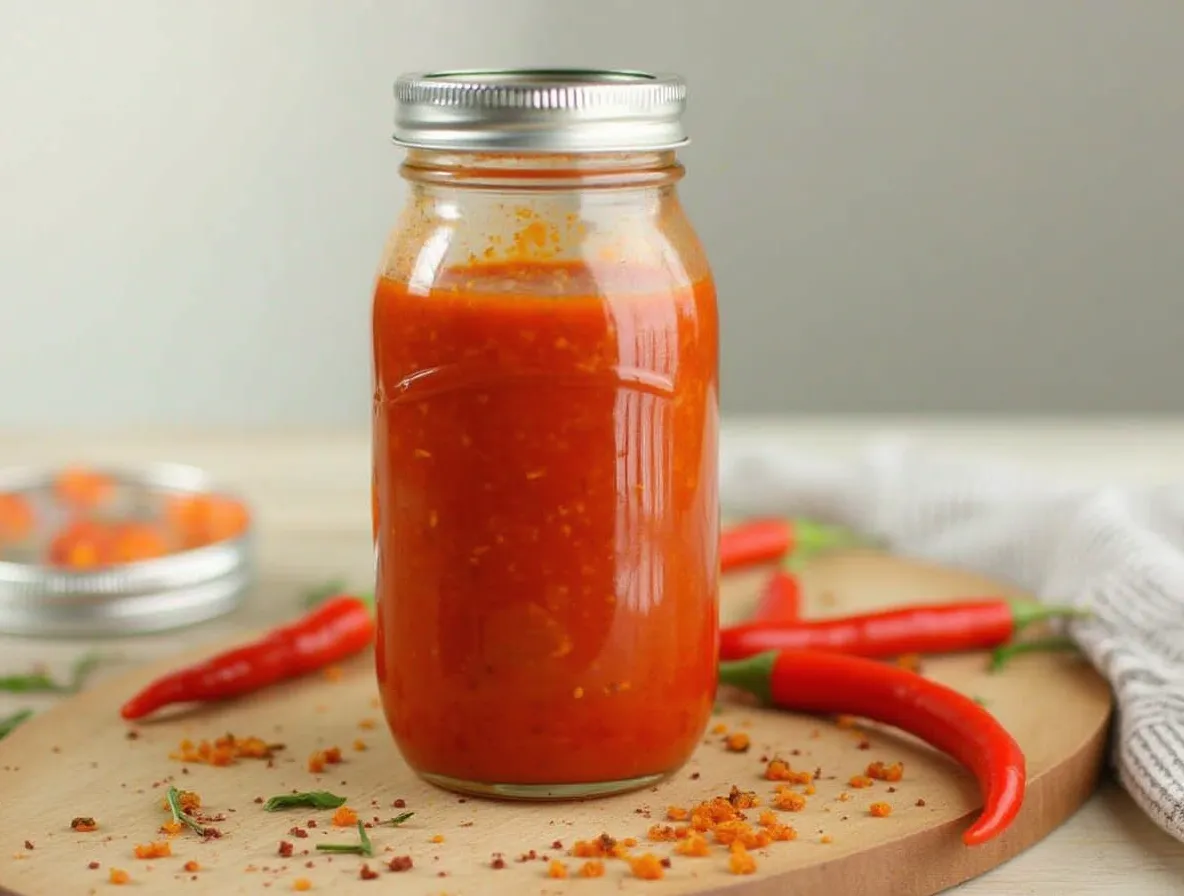Easy homemade hot sauce with 3 pepper types
You ever take a bite of food and think, “This needs something… bold. Tangy. Fiery.” Yep, that’s the magic of hot sauce. And not just any bottle off the grocery shelf — I’m talking about homemade hot sauce. Made from scratch in your kitchen, tailored to your taste buds, and packed with fresh, flavorful fire.
Whether you’re a chili pepper connoisseur or someone who just wants a little kick in their tacos, learning how to make hot sauce at home is a game-changer. It’s not only fun and surprisingly easy, but also lets you control the heat, flavor, and ingredients. Plus, it makes a killer gift or dinner party flex — because let’s be honest, “I made this hot sauce myself” sounds way cooler than “I got it at the store.”
So why this recipe? Because it’s designed for real people — busy home cooks, hot sauce fans, spicy food lovers, and total beginners. Whether you’re spicing up wings, tacos, or your morning eggs, this DIY hot sauce recipe will turn you into the sauce boss of your kitchen.
Let’s dive in — I’ll walk you through every step, pepper by pepper.
Why this recipe is perfect for spicy food lovers
This homemade hot sauce recipe is perfect if:
- You want to avoid artificial preservatives and added sugars
- You crave a custom flavor profile tailored to your heat tolerance
- You’re looking for a fermented or vinegar-based hot sauce option
- You love experimenting in the kitchen
- You want a small-batch recipe that scales up easily
Quick overview of the recipe and its benefits
At a glance, here’s why this homemade spicy sauce should be your new go-to:
- Ready in under 30 minutes (plus optional fermentation)
- Fully customizable heat level
- Works with jalapeños, habaneros, ghost peppers, or any chili variety
- Can be stored for weeks to months with proper bottling
- Bursting with fresh, bold, tangy flavor
Ingredients
Essential ingredients for homemade hot sauce
Here’s what you’ll need to craft a bold, flavorful batch of hot sauce from scratch:
| Ingredient | Quantity | Notes |
|---|---|---|
| Fresh chili peppers | 10–12 | Use jalapeños, habaneros, or a mix |
| Garlic cloves | 3–4 | Adds savory depth |
| White or apple cider vinegar | ½ cup | For acidity and preservation |
| Sea salt | 1 tsp | Balances and boosts flavor |
| Water | ¼–½ cup | Adjust for desired thickness |
| Lime juice | 2 tbsp | Adds brightness |
| Onion (optional) | ½ small | Adds mild sweetness and flavor |
These are the basics, but you can always get creative. (We’ll get into variations later!)
Substitutes for key ingredients
- Vinegar: Try rice vinegar or lemon juice if you’re out of apple cider vinegar.
- Chili peppers: Want less heat? Use Anaheim or Fresno peppers. More heat? Go wild with ghost or scorpion peppers.
- Lime juice: Lemon juice works in a pinch but changes the flavor profile slightly.
Equipment Needed
Essential tools for making homemade hot sauce
Here’s what you’ll want on hand:
- Blender or food processor
- Cutting board and sharp knife
- Medium saucepan
- Mason jar or glass bottle
- Gloves (if using hot peppers)
Optional equipment for enhanced results
- Fermentation weights
- Funnel for bottling
- Fine mesh strainer (for smoother sauce)
- Glass jars with airtight lids
What to look for in equipment
- Best knife for chili peppers: Use a sharp, non-serrated blade to avoid crushing the skin.
- Best blender: A high-speed blender creates a silky-smooth sauce, but a standard one gets the job done too.
- Storage bottles: Look for dark glass to preserve flavor and extend shelf life.

Step-by-Step Instructions
Step one: Choose and prep your peppers
Pick your heat level! Jalapeños are milder, habaneros bring fruity heat, and ghost peppers are for those who love danger. Rinse and remove stems. For less heat, take out the seeds and membranes — that’s where the real fire lives.
Wear gloves while handling hot peppers. Trust me, the capsaicin doesn’t mess around.
Step two: Sauté your aromatics
In a medium pan over medium heat, sauté chopped garlic and onion in a bit of oil until fragrant. This brings out their sweetness and reduces harshness.
Optional: lightly roast the peppers to deepen the flavor. Adds a rich, smoky layer.
Step three: Blend everything together
Toss your peppers, garlic, onion, vinegar, lime juice, and salt into the blender. Add water to help it blend smoothly. Start with less water and add as needed for your preferred consistency.
Blend until smooth. You can strain for a thinner sauce or keep it chunky — your call.
Step four: Simmer for shelf life
Pour your mixture into a saucepan and simmer for 10–15 minutes. This helps blend the flavors and ensures food safety if you’re not fermenting.
Cool slightly before bottling.
Step five: Bottle and store
Transfer your sauce into sterilized glass bottles or mason jars. Store in the fridge for up to 3 months.
For longer shelf life, use proper fermentation and canning techniques.
Tips and Tricks for Success
Time of cooking
You can whip up a fresh, unfermented hot sauce in 30 minutes. Fermentation adds complexity but takes 5–7 days.
How to make hot sauce even better
- Use a mix of peppers for complex flavor.
- Let it sit for a day or two — flavors deepen.
- Add fruits like mango or pineapple for a sweet kick.
Common mistakes to avoid
- Not wearing gloves. Seriously. Don’t find out the hard way.
- Skipping vinegar. It’s not just for taste — it’s for preservation.
- Over-blending. If you want texture, pulse — don’t puree.
Time-saving tips for hot sauce
- Chop ingredients in advance and freeze them in prep bags.
- Double the recipe and store in small bottles.
- Use pre-minced garlic to cut prep time.
Variations and Substitutes
Hot sauce variations for different diets
- Vegan: This recipe is naturally vegan.
- Low-sodium: Reduce the salt and boost flavor with citrus or herbs.
- Sugar-free: Sweetness from fruit (like mango) without added sugar.
Creative twists to try
- Fermented hot sauce: Combine your ingredients (minus vinegar), salt them, and let them ferment in a mason jar for 5–7 days before blending.
- Smoky chipotle hot sauce: Use dried chipotles or smoked paprika for depth.
- Caribbean-style hot sauce: Add mustard, turmeric, and fruit like papaya or mango.
How to Serve Homemade Hot Sauce
Best side dishes to pair with hot sauce
- Tacos and burritos
- Grilled chicken or shrimp
- Scrambled eggs or omelets
- Mac and cheese (yes, really)
- Roasted vegetables
Serving suggestions for different occasions
- Barbecues: Serve in labeled bottles with varying spice levels.
- Dinner parties: Pair with charcuterie boards for a spicy surprise.
- Meal prep: Drizzle on rice bowls or roasted veggies to spice up your week.
Nutritional Information
Calories per serving
Roughly 10–15 calories per tablespoon, depending on the peppers and optional ingredients used.
Other key nutrients
- Vitamin C from fresh peppers and lime
- Capsaicin, which may boost metabolism and reduce inflammation
- Antioxidants from garlic and onion
How to make hot sauce healthier
- Use less salt
- Add turmeric or ginger for anti-inflammatory properties
- Go heavy on citrus and light on sugar
Conclusion
If you’ve made it this far, you’re officially ready to make the best homemade hot sauce your kitchen (and taste buds) have ever seen. It’s not just a condiment — it’s an experience. A statement. A celebration of flavor and fire.
From mild jalapeño blends to fiery ghost pepper mash-ups, this recipe is your blank canvas. Add your twist, adjust the heat, bottle it up, and brag about it every chance you get.
You’ll never go back to store-bought again. I haven’t.
Ready to bring the heat?
🔥Let me know how your homemade hot sauce turned out in the comments!
🔥Share this recipe with your fellow spice-lovers.
🔥Follow us on Instagram and Pinterest for more DIY sauces and spicy recipes.
FAQs
How long does homemade hot sauce last?
When stored in a sterilized bottle in the fridge, it lasts up to 3 months. If fermented and properly bottled, it can last even longer — sometimes up to a year.
What are the best peppers to use for homemade hot sauce?
That depends on your heat preference. Jalapeños are mild and earthy, habaneros are fruity and spicy, and ghost peppers bring serious heat. Mixing different types gives you complexity in both flavor and fire.
Is it better to ferment hot sauce or cook it?
Fermenting adds probiotic benefits and a more complex, tangy flavor — but it takes days. Cooking is quicker, safer for beginners, and still produces a delicious result. Try both and see what you prefer!
Can I make hot sauce without vinegar?
Technically yes, especially if you ferment it. But vinegar adds acid, balances flavor, and extends shelf life. If you avoid vinegar for dietary reasons, use lemon juice or lactic fermentation to maintain acidity.
How do I reduce the heat in my homemade hot sauce?
Remove the seeds and membranes from the peppers — that’s where the heat is concentrated. You can also use milder peppers like poblanos, bell peppers, or banana peppers, and balance with sweetness like mango or honey.

